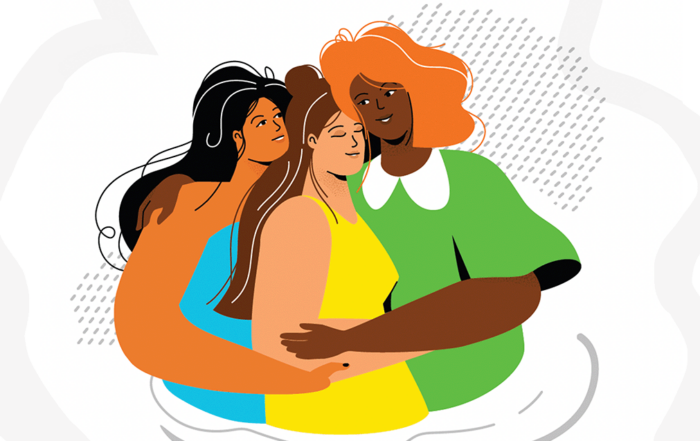Overview
Remedying workplace gender inequality continues to be a pressing issue for organizations. Companies are taking bold actions to address gendered gaps in wages and workplace promotions like boardroom gender quotas and targeted recruiting. However, current efforts focus almost exclusively on the challenges cisgender (meaning, individuals who identify with the biological sex assigned at birth) women face. This research brief provides an overview of the academic research on the economic and workplaces experiences of trans and nonbinary people, identifying the gaps and topics where more research is needed.
Current gender equality efforts often neglect the experiences of the estimated 1.5 million adults in the United States and Canada who identify as transgender.
This matters because it means that an estimated 1.5 million adults in the United States and Canada who identify as trans (meaning, individuals who may not exclusively identify with the biological sex assigned at birth) are neglected.[1] This neglect impacts the effectiveness of everything from data on the gender pay gap to employment equity initiatives. Research continues to show that trans and nonbinary (meaning, individuals who do not identify exclusively as either a man or woman) people face structural barriers, biases, and discrimination at work because of their gender identity and expression, barriers that are more extreme for racialized and gender non-conforming individuals.[2] Nonetheless, the majority of research on gender inequality at work continues examine inequalities between cisgender men and women.
Demographics are changing, and so are societal views about gender.
Researchers estimate as many as 12 percent of millennials, who now comprise more than 35 percent of the United States workforce, identify as trans or nonbinary, more than double those from Generation X.[3] A 2019 Pew Research study found those between the ages of 13 and 21 to be more familiar and accepting of gender diversity. They found 35 percent of those surveyed between 13 and 21 knew someone who used gender-neutral pronouns, and 59 percent believed forms and documents should provide gender options beyond “male” and “female.”[4] Organizations should begin thinking beyond the binary not only to support their current employees but also to prepare for the future.
What the research tells us about trans and nonbinary workers
Trans and nonbinary people continue to face overt and subtle discrimination at work.
From over a decade’s worth of qualitative and survey data on the economic experiences of trans and nonbinary people in the United States and Canada, we know that trans and nonbinary people face social barriers and discrimination while seeking to obtain and sustain employment, issues that are compounded for racialized and Indigenous trans people.[5] These include:
- Overt discrimination and harassment: Overtly discriminatory practice include employers refusing to use the employees’ preferred pronouns and names in the workplace and on formal documents like job reviews, and government-driven policies such as placing restrictions or limitations on transgender people from changing government-issued IDs.[6]
- Subtle microaggressions: There are also subtle forms of discrimination that trans people face at work called microaggressions. Microaggressions are statements or behaviours that are not intentionally discriminatory but inflict harm by reflecting power imbalances and stereotypes of marginalized groups.[7] This can include the use of transphobic language, like intentionally calling transgender people by their incorrect gender pronoun, or denying the reality of transphobia, like telling a transgender woman who says she’s experienced discrimination that she is being too sensitive.[8]
Both overt and subtle discrimination undermines well-being and promotes hypervigilance, negatively impacting workplace outcomes.[9]
Transgender discrimination threatens employment stability, and begins as early as childhood.
Structural barriers threaten employment stability for trans and nonbinary workers, including inadequate access to trans-affirming healthcare, housing and services discrimination, bullying and isolation, and lack of social support from family due to identity stigma.[10]
An Ontario-wide survey from 2010 found discrimination to have had systemic impacts on the employment outcomes of trans people:
- Fifty percent of trans people earn $15,000 or less per year, even though 71 percent have some form of post-secondary education.[11]
- The unemployment rate for transgender and gender nonconforming respondents in Ontario has been estimated to be 20 percent, more than double the provincial average.[12]
More recent data from the U.S. Transgender Discrimination Survey reports:
- Trans people were four times more likely to have a household income of less than $10,000 per year compared the national average in the U.S.[13]
- Data from this survey found that racialized transgender women, who contend with intersecting marginalizations, including transmisogyny and racism, are subjected to even higher levels of discrimination and violence at work.[14]
Structural barriers threaten employment stability for trans and nonbinary workers, including inadequate access to trans-affirming healthcare, housing and services discrimination, bullying and isolation, and lack of social support from family due to identity stigma.
Transphobia also presents considerable barriers to employment even for those who are not initially economically marginalized, especially for trans women. A 2011 national survey found that 90 percent of trans people surveyed reported experiencing employment discrimination, including being fired, denied a promotion or being harassed.[15] However, this does not include trans people who face discrimination while seeking employment. Discriminatory hiring for transgender people has been commonly reported. The first government-run audit study examining the role of gender identity from applicants in the United States found trans people to be significantly less likely than cisgender people to receive a positive response about a job application across job sectors.[16]
Family conflict has meant that transgender youth disproportionately make up the homeless population in North America.[17] Estimates suggest that LGBTQ youth make up as much as 40% of the homeless population, whereas approximately five to ten percent of youth identify as LGBTQ.[18] These obstacles are the result of historical inequalities due to discrimination including stigma and negative stereotypes about what it means to be a man or a woman.[19] Transgender and nonbinary individuals who experience identity misclassification can have negative psychological impacts, including feeling stigmatized, having a reduced sense of worth, and anxiety and depression.[20]
Not all transgender people experience the same kinds of discrimination.
Though it is important to be aware of the discrimination that trans people face as a community. It is also essential to understand that not all trans and nonbinary people face the same kinds of challenges: research demonstrates that trans women of colour have worse employment outcomes than trans men and nonbinary trans individuals; however, black nonbinary individuals have the worst employment outcomes overall.[21] Population-wide data has shown that individuals who are economically marginalized and gender nonconforming have a higher odds of reporting worse health outcomes than transgender and cisgender men and women.[22]
Empirical data from a 2019 study in the United States demonstrated that organizational context as well as social and economic location impacts employment outcomes. Across more than 300,000 workers in 28 federal agencies in the United States, LGBT women and people of colour reported more negative experiences, including workplace fairness, employee treatment, and job satisfaction, than cisgender men and white LGBT workers.[23]
Gender diverse data gaps remain
Due to historical discrimination, transgender people are not represented in national data and are elsewhere insufficiently represented in data collection.[24] This leaves gaps in the data on the population estimates of trans people, a knowledge gap which subsequently impacts the effectiveness of everything from the gender pay gap to employment equity initiatives. More robust data on trans and nonbinary people is important to make visible an often overlooked community and necessary in order to better inform policy.[25]
Gender diverse data gaps impact the effectiveness of everything from the gender pay gap to employment equity initiatives. These gaps include:
Population data: In Canada, for example, pay equity data is calculated from census data based only on biological sex. Current employment equity strategies for the City of Toronto, for example, rely upon census data to evaluate workforce percentage representation against Toronto population estimates. Though trans people are identified as an equity-seeking group, they are bundled into the larger Lesbian, Gay, Bisexual, Trans, Queer, Two-Spirit (LGBTQ2S) communities, who due to discrimination, have been historically excluded from the census. Data from the 2018 City of Toronto public services survey show a 4 percent workforce representation for LGBTQ2S communities; however, since there is no official LGBTQ2 population estimate, and no disaggregation of trans and nonbinary specific data, employment equity for trans people cannot be adequately evaluated.[26]
Preliminary research from population surveys with gender measures that include options beyond male and female have identified patterns of inequality align with gender identity more than biological sex.[27]
Subpopulation data: Though surveys are beginning to capture data on trans people, nonbinary individuals are more often excluded from data collection. Due to decades of research and activism, we know more about the workplace experiences of binary transgender people than nonbinary workers. Epidemiological data shows that only a small minority of trans people in Canada reported a “linear transition” from one binary gender to another.[28] Moreover many gender nonconforming and nonbinary individuals do not “transition” from one binary gender to another with medical assistance.[29]
Since 2014 the U.S. based Behavioral Risk Factors Surveillance System survey (BRFSS) has enabled participants to identify as either transgender man or woman, gender-nonconforming, or a cisgender man or woman.[30] A 2019 study using data from the BRFSS found gender nonconforming respondents to be twice as likely as cisgender men to self-report poor health after controlling for socioeconomic factors.[31]
Due to historical discrimination, transgender people are not represented in national data and are elsewhere insufficiently represented in data collection. More robust data on trans and nonbinary people is important to make visible an often overlooked community and to better inform policy.
Longitudinal data: Studies of the outcomes of trans people at work require data collection across periods of time. However, research studying the outcomes of trans people has been limited due to historical stigma. Most studies examine trans people either during or right after their transitions. However, there is little data about the long-term outcomes of trans people. There is potential for recent large-scale transgender health cohort studies, like the largest transgender study being conducted European Network for the Investigation of Gender Incongruence, which follows 2,600 participants across four clinics in Europe, to share and collaborate using their longitudinal economic and employment data.[32]
Measuring gender identity and expression
Though best practices on sex and gender data collection are evolving, current recommendations for trans-inclusive measurement suggest a multi-dimensional sex/gender measure that includes items asked to the subgroup of those who indicate their gender identity differs from their sex assigned at birth.[33] This is important for organizations as they continue to build data collections practices for demographic data on their employees.
There is continued debate not only how but also whether or not it would be beneficial to build more inclusive gender identity measures.
Survey research has show there is widespread interest in including trans people in the US census from trans communities.[34] However, there are challenges to data collection as well, including how to conduct research given the small size of the trans population; and, how to measure trans communities given changing understandings and meanings of gender identity and expression.[35] Much of the research on trans and nonbinary people’s experiences come from qualitative interviews due in part to a commitment to a person’s individual experience of gender.[36]
Activists and scholars have also articulated how some people are wary of disclosing their trans identities given the histories of violence and discrimination against trans people in government policies and practices.[37] Other researchers caution that there are currently no processes to ensure that more inclusive gender measures and related policies would prevent further discrimination against trans employees.[38] This means it is essential to ensure data privacy protocols are in place and clear reasons for gathering the data, such as employment equity, if a company plans to capture sex and gender data from their employees.[39]
The gender binary impacts everyone, not just transgender people
Organizations should think beyond the gender binary not only to support their trans and nonbinary employees but because the gender binary sustains workplace gender discrimination. This impacts cisgender people as well. Gender stereotypes and work structures influence work experiences, practices, and policies.[40] Recent research demonstrates that men face backlash for straying from masculine gender norms—like displaying empathy or expressing sadness.[41] Additionally, meritocracy and biological differences between men and women are two ways that organizations justify gender inequalities in promotion practices. Ironically, trans women report losing high powered work positions once they come out as a woman.[42] While trans men report being more respected once they are seen as men than when they were perceived as women at work.[43]
Transgender people are encouraged to enforce the gender binary at work.
A recent study on transgender workplace discrimination at Stanford University observed that transgender people often had to compromise their authenticity at work in order to “fit in” and avoid discrimination or “maintain their authenticity” and face discrimination and often firing.[44] Research has demonstrated that unsupportive or hostile colleagues means that transgender employees are pressured to hide their gender identity at work.[45] A 2019 Human Rights Campaign survey found that nearly two thirds of non-LGBTQ employees found it “unprofessional” to discuss gender identity at work.[46]
Addressing gender identity and expression discrimination at work
Many employers have begun to acknowledge transgender workers by adopting antidiscrimination best practices and policies. According the Human Rights Campaign, nearly 85 percent of Fortune 500 companies have policies against gender identity discrimination, up from 3 percent in 2002.[47] Additionally, 62 percent of Fortune 500 companies offer transgender-inclusive benefits, up from 0 percent in 2002. In the United States, there are currently no federal protections prohibiting employment discrimination based upon gender identity and gender expression.[48] In 2017, the Canadian Human Rights Act was amended to include workplace protection against discrimination based upon gender identity and expression. Despite protections research suggests a gap exists between the adoption of antidiscrimination policies, often adopted through processes of diffusion to avoid litigation and maintain a positive public image, and the prevention of discrimination against transgender workers.[49] More research is necessary to understand the best mechanisms to better support trans and nonbinary workers.
Though there is much that we do not know, research suggests that following tools and practices are a good place to begin:
- Strengthen gender identity and expression protections and prevention measures within organizations if they do not already exist.
- Do a “gender audit” of your policies and practices to identify when and how you invoke gender.[50] Ensure you are not unintentionally “gender policing” in policies like dress codes.[51]
- Assume that there are trans and nonbinary people in your organization even when they are not visible.
- Understand that the employment barriers that transgender people face are distributed unequally.
- Partner with trans people and community organizations to challenge stereotypes, provide training, and build trans employment pipelines and practices.
- Hire openly transgender and nonbinary people even if they force you to challenge your own gender biases. Foster a work environment where people can be authentic. This benefits everyone, not just transgender people.
This research overview was prepared by Bretton Fosbrook under the supervision of Professor Sarah Kaplan.
References
[1] Scheim, A. I., & Bauer, G. R. (2015). Sex and gender diversity among transgender persons in Ontario, Canada: results from a respondent-driven sampling survey. The Journal of Sex Research, 52(1), 1-14.; Flores, A.R., Herman, J. L., Gates, G. J., & Brown, T. N. (2016). “How many adults identify as transgender in the United States?” The Williams Institute.
[2] Badgett, M. V., Lau, H., Sears, B., & Ho, D. (2007). Bias in the workplace: Consistent evidence of sexual orientation and gender identity discrimination; Dietert, M., & Dentice, D. (2009). Gender identity issues and workplace discrimination: The transgender experience. Journal of Workplace Rights, 14(1).; Connell, C. (2010). Doing, undoing, or redoing gender? Learning from the workplace experiences of transpeople. Gender & Society, 24(1), 31-55.
[3] Fry, R. (April 11, 2018) “Millennials are the largest generation in the U.S. labor force,” Pew Research Center, https://www.pewresearch.org/fact-tank/2018/04/11/millennials-largest-generation-us-labor-force/ Retrieved 18 July 2019; GLAAD. (2017). “Accelerating Acceptance: A Harris Poll survey of Americans’ acceptance of LGBTQ people,” https://www.glaad.org/files/aa/2017_GLAAD_Accelerating_Acceptance.pdf. Retrieved 18 July 2019.
[4] Parker, K., Graf, N., & Igielnik, R. (2019). Generation Z Looks a Lot Like Millennials on Key Social and Political Issues. Pew Research Center’s Social & Demographic Trends Project.
[5] Kuper, L. E., Nussbaum, R., & Mustanski, B. (2012). Exploring the diversity of gender and sexual orientation identities in an online sample of transgender individuals. Journal of sex research, 49(2-3), 244-254.; Badgett, M. V., Lau, H., Sears, B., & Ho, D. (2007). Bias in the workplace: Consistent evidence of sexual orientation and gender identity discrimination; Bauer, G. R., Hammond, R., Travers, R., Kaay, M., Hohenadel, K. M., & Boyce, M. (2009). “I don’t think this is theoretical; this is our lives”: how erasure impacts health care for transgender people. Journal of the Association of Nurses in AIDS Care, 20(5), 348-361.; Connell, C. (2010). Doing, undoing, or redoing gender? Learning from the workplace experiences of transpeople. Gender & Society, 24(1), 31-55.
[6] Bender-Baird, K., 2011. Transgender employment experiences: Gendered perceptions and the law. SUNY Press.
[7] Sue, D.W. ed., 2010. Microaggressions and marginality: Manifestation, dynamics, and impact. John Wiley & Sons.
[8] Nadal, K.L., Whitman, C.N., Davis, L.S., Erazo, T. and Davidoff, K.C., 2016. Microaggressions toward lesbian, gay, bisexual, transgender, queer, and genderqueer people: A review of the literature. The Journal of Sex Research, 53(4-5), pp.488-508.
[9] Thoroughgood, C. N., Katina B. Sawyer, and Jennica R. Webster. “What lies beneath: how paranoid cognition explains the relations between transgender employees’ perceptions of discrimination at work and their job attitudes and wellbeing.” Journal of Vocational Behavior 103 (2017): 99-112.
[10] Grant, J.M., Mottet, L., Tanis, J.E., Harrison, J., Herman, J. and Keisling, M., 2011. Injustice at every turn: A report of the National Transgender Discrimination Survey. National Center for Transgender Equality.
[11] Bauer, G., Nussbaum, N., Travers, R., Munro, L., Pyne, J., Redman, N., Scanlon, K. and Travers, R., 2011. We’ve got work to do: workplace discrimination and employment challenges for trans people in Ontario. Trans PULSE e-Bulletin, 2(1), pp.1-3.
[12] Bauer, G., Nussbaum, N., Travers, R., Munro, L., Pyne, J., Redman, N., Scanlon, K. and Travers, R., 2011. We’ve got work to do: workplace discrimination and employment challenges for trans people in Ontario. Trans PULSE e-Bulletin, 2(1), pp.1-3.
[13] James, S.E., Herman, J.L., Rankin, S., Keisling, M., Mottet, L. and Anafi, M.A., 2016. The report of the 2015 US transgender survey. Washington, DC: National Center for Transgender Equality.
[14] James, S.E., Herman, J.L., Rankin, S., Keisling, M., Mottet, L. and Anafi, M.A., 2016. The report of the 2015 US transgender survey. Washington, DC: National Center for Transgender Equality.
[15] Grant, J.M., Mottet, L., Tanis, J.E., Harrison, J., Herman, J. and Keisling, M., 2011. Injustice at every turn: A report of the National Transgender Discrimination Survey. National Center for Transgender Equality.
[16] Rainey, T., Imse, E., & Pomerantz, A. (2015). Qualified and transgender: A report on results of resume testing for employment discrimination based on gender identity. Washington, DC: Office of Human Resources. ohr. dc. gov/sites/default/files/dc/sites /ohr/publication/attachments /Qualifiedan dTransgender_FullReport_1. pdf.
[17] Public Health Agency of Canada. (2006). Street youth in Canada: Findings from the enhanced surveillance of Canadian street youth, 1999-2003. Ottawa: Government of Canada.
[18] Abramovich, A. “No safe place to go-LGBTQ youth homelessness in Canada: Reviewing the literature.” Canadian Journal of Family and Youth/Le Journal Canadien de Famille et de la Jeunesse 4, no. 1 (2012): 29-51.
[19] Westbrook, L. and Schilt, K., 2014. Doing gender, determining gender: Transgender people, gender panics, and the maintenance of the sex/gender/sexuality system. Gender & Society, 28(1), pp.32-57.
[20] McLemore, Kevin A. “Experiences with misgendering: Identity misclassification of transgender spectrum individuals.” Self and Identity 14, no. 1 (2015): 51-74.
[21] Davidson, S., 2016. Gender inequality: Nonbinary transgender people in the workplace. Cogent Social Sciences, 2(1), p.1236511.
[22] Lagos, D. (2018). Looking at population health beyond “male” and “female”: implications of transgender identity and gender nonconformity for population health. Demography, 55(6), 2097-2117.
[23] Cech, E. A. and Rothwell, W. R. (2019). LGBT Workplace Inequality in the Federal Workforce: Intersectional Processes, Organizational Contexts, and Turnover Considerations. ILR Review, 0019793919843508.
[24] Greytak, E.A., Gill, A.M., Conron, K.J. and Herman, J.L., 2014. Best Practices for Asking Questions to Identify Transgender and Other Gender Minority Respondents on Population-Based Surveys.
[25] Brown, T. N. T., Herman, J. L., Park, A. S. (2017). Exploring International Priorities and Best Practices for the Collection of Data about Gender Minorities, Report of Meeting. Los Angeles, CA: The Williams Institute.
[26] City of Toronto. Report on fostering diversity in the Toronto Public Service. 5 June 2018.
[27] Lagos, D. (2018). Looking at population health beyond “male” and “female”: implications of transgender identity and gender nonconformity for population health. Demography, 55(6), 2097-2117.
[28] Scheim, A.I. and Bauer, G.R., 2015. Sex and gender diversity among transgender persons in Ontario, Canada: results from a respondent-driven sampling survey. The Journal of Sex Research, 52(1), pp.1-14.
[29] Matsuno, E. and Budge, S.L., 2017. Non-binary/genderqueer identities: A critical review of the literature. Current Sexual Health Reports, 9(3), pp.116-120.
[30] Waite, S., & Denier, N. (2019). A Research note on Canada’s LGBT data landscape: Where we are and what the future holds. Canadian Review of Sociology/Revue canadienne de sociologie, 56(1), 93-117.
[31] Lagos, D. (2018). Looking at population health beyond “male” and “female”: implications of transgender identity and gender nonconformity for population health. Demography, 55(6), 2097-2117
[32] Reardon, S. (2019). The largest study involving transgender people is providing long-sought insights about their health. Nature 568, 446-449.
[33] Bauer, G.R., Braimoh, J., Scheim, A.I. and Dharma, C., 2017. Transgender-inclusive measures of sex/gender for population surveys: Mixed-methods evaluation and recommendations. PloS one, 12(5), p.e0178043.
[34] Schilt, K. and Bratter, J., 2015. From multiracial to transgender? Assessing attitudes toward expanding gender options on the US Census. TSQ: Transgender Studies Quarterly, 2(1), pp.77-100.
[35] Waite, S., & Denier, N. (2019). A Research note on Canada’s LGBT data landscape: Where we are and what the future holds. Canadian Review of Sociology/Revue canadienne de sociologie, 56(1), 93-117.
[36] Schilt, K., & Lagos, D. (2017). The development of transgender studies in sociology. Annual Review of Sociology, 43, 425-443.
[37] Spade, D., 2015. Normal life: Administrative violence, critical trans politics, and the limits of law. Duke University Press.
[38] Munsch, C.L. and Elizabeth Hirsh, C., 2010. Gender variance in the Fortune 500: The inclusion of gender identity and expression in nondiscrimination corporate policy. In Gender and Sexuality in the Workplace (pp. 151-177). Emerald Group Publishing Limited.
[39] Davis, H.F., 2018. Beyond trans: Does gender matter? NYU Press.
[40] Padavic, I. and Reskin, B.F., 2002. Women and men at work. Pine Forge Press.
[41] Mayer, D.M. 2018. How men get penalized for straying from masculine norms. Harvard Business Review. 8 October.
[42] Griggs, C., 1998. S/he: Changing sex and changing clothes. Berg Publishers.
[43] Schilt, K., 2010. Just one of the guys?: Transgender men and the persistence of gender inequality. University of Chicago Press.
[44] Fogarty, A, and L. Zheng. 2018. Gender Ambiguity in the Workplace: Transgender and Gender-diverse Discrimination. ABC-CLIO.
[45] Brewster, M. E., Velez, B. L., Mennicke, A., & Tebbe, E. (2014). Voices from beyond: A thematic content analysis of transgender employees’ workplace experiences. Psychology of sexual orientation and gender diversity, 1(2), 159.
[46] Fidas, D. and L. Cooper, A. (2019) Workplace Divided: Understanding the Climate for LGBTQ Workers Nationwide. (Human Rights Campaign).
[47] Human Rights Commission (2019) “Corporate Equality Index 2019.” https://assets2.hrc.org/files/assets/resources/CEI-2019-FullReport.pdf?_ga=2.65847022.1178254233.1564417991-505415734.1555082187. Retrieved 21 July 2019.
[48] United States Equal Employment Opportunity Commission, “What You Should Know About EEOC and the Enforcement Protections for LGBT Workers.”
[49] Weiss, J. T. 2004. The cutting edge of employment diversity: Transgender human resources policies in U.S. employers (Doctoral dissertation). Boston, MA: Northeastern University.
[50] Fogg Davis, H. (2018) https://heathfoggdavis.com/building-gender-inclusive-organizations-the-workbook/
[51] Barry, B. (2017). What happens when men don’t conform to masculine clothing norms at work? Harvard Business Review, 31 August.
Research overview prepared by
Bretton Fosbrook, Postdoctoral Fellow
Published
October 2019







